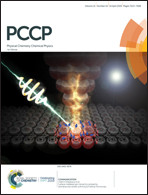Insight into the halogen-bond nature of noble gas-chlorine systems by molecular beam scattering experiments, ab initio calculations and charge displacement analysis†
Abstract
We have carried out molecular-beam scattering experiments and high-level ab initio investigations on the potential energy surfaces of a series of noble-gas–Cl2 adducts. This effort has permitted the construction of a simple, reliable and easily generalizable analytical model potential formulation, which is based on a few physically meaningful parameters of the interacting partners and transparently shows the origin, strength, and stereospecificity of the various interaction components. The results demonstrate quantitatively beyond doubt that the interaction between a noble-gas (Ng) atom – even He – and Cl2 in a collinear configuration is characterized by weak halogen bond (XB) formation, accompanied by charge transfer (CT) from the Ng to chlorine. This characteristic, which stabilizes the adduct, rapidly disappears on going towards the T-shaped configuration, dominated by pure van der Waals (vdW) forces. Similarly, a pure vdW interaction takes place – with no CT component in any configuration – if Cl2 is present in the lowest πg* → σu* excited state, because the change in electron density that accompanies the excitation eliminates the Cl2 polar flattening and σ hole, making the XB interaction inaccessible.

- This article is part of the themed collection: 2019 PCCP HOT Articles


 Please wait while we load your content...
Please wait while we load your content...